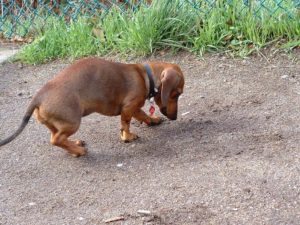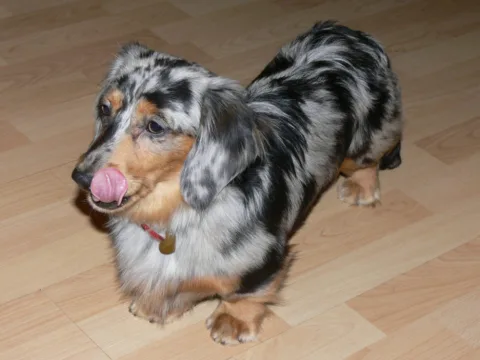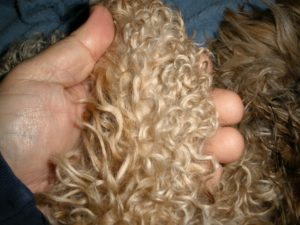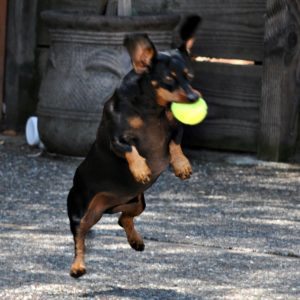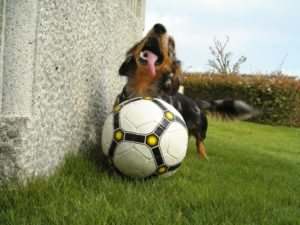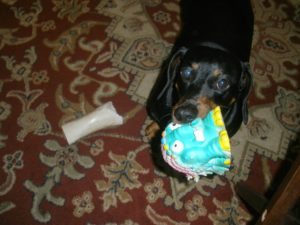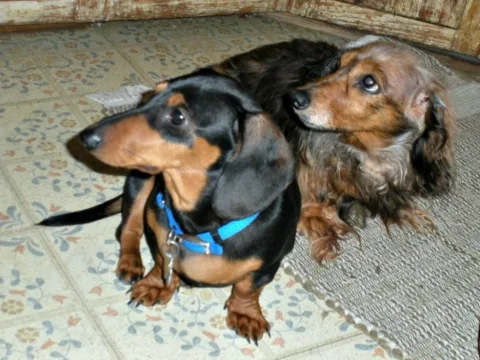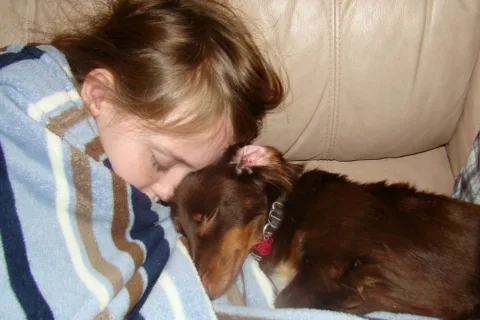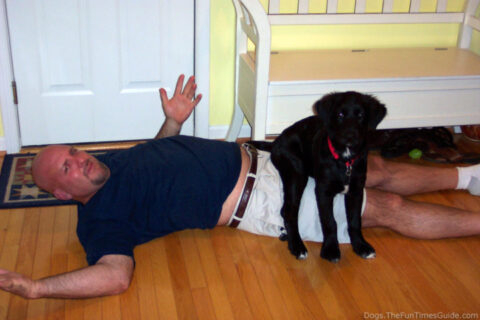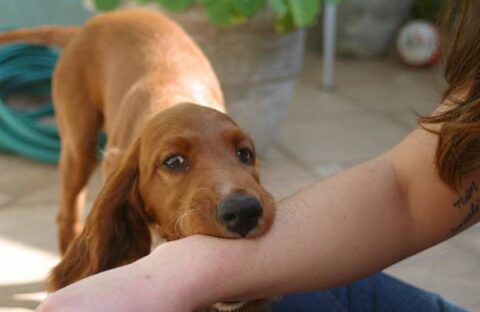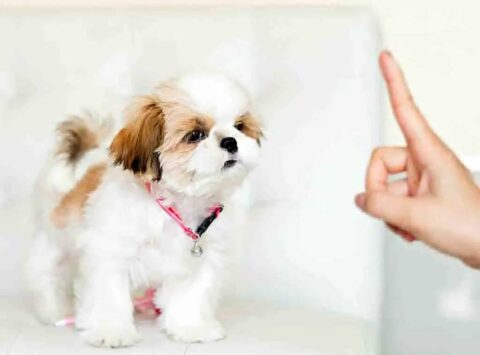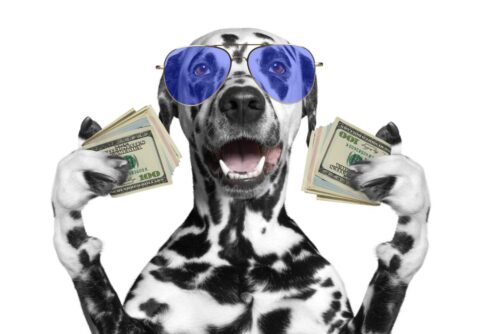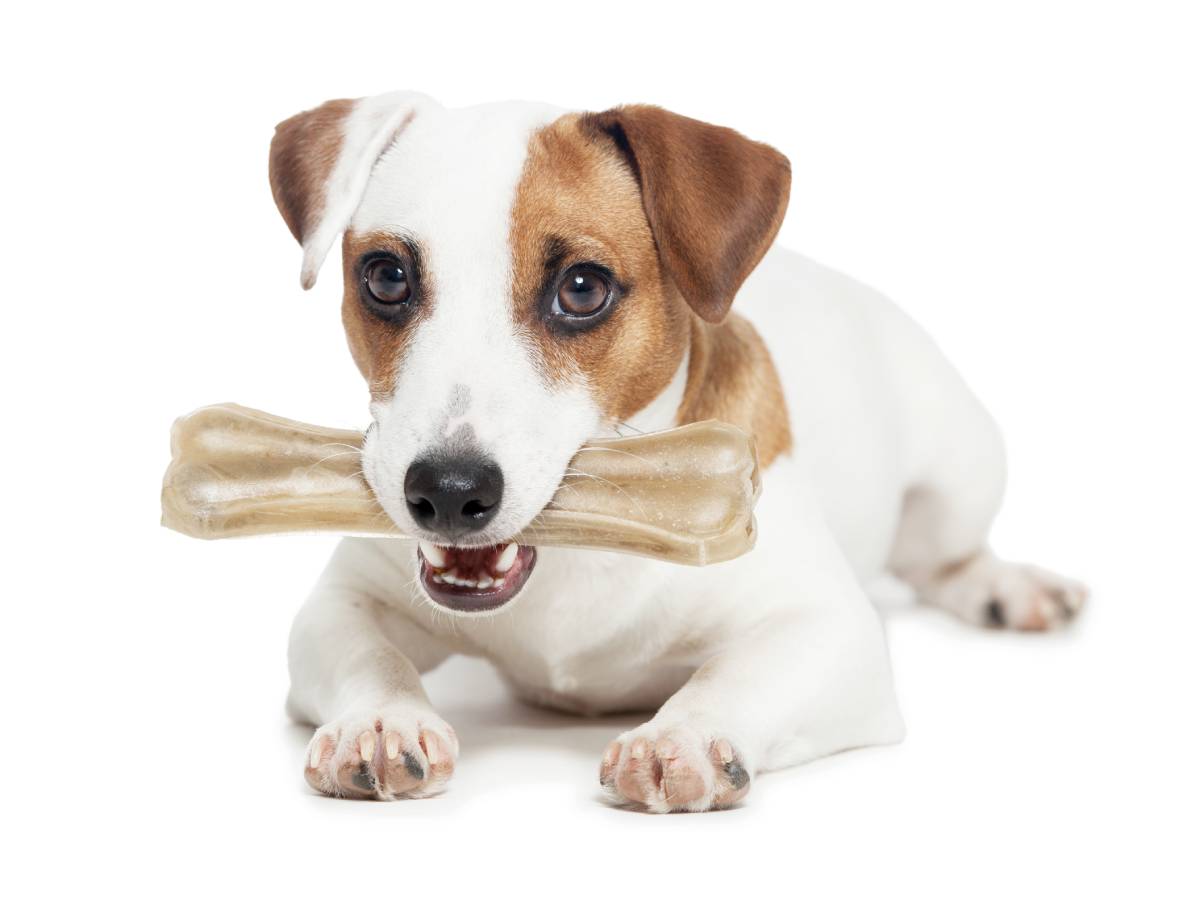One of my dog’s four-legged friends is a Dachshund named Lucy. Some other friends of ours have Dachshunds, too.
The Dachshund dog (aka Doxie dog or wiener dog) is easy to recognize by its:
- Long, low body
- Short legs
- Pointed snout
If you’re thinking of adding a Dachshund to your family, you’re not alone. They’ve been a favorite with families for many years — with good reason.
But there are also some things you need to know about before you bring home a Dachshund for the first time.
So, today we’ll take a closer look at this fun-loving, spirited dog that many people choose for a household pet.
History Of The Dachshund
Dachshunds originated in Germany — where they are known as the teckel.
The breed’s population fell very low during World War I. However, many Dachshunds were brought to the United States after the war, and their numbers increased dramatically.
The long, low body style of the Dachshund was bred for a particular purpose: to flush out rabbits and badgers from their burrows in the ground. The breed’s tenacious spirit allowed it to fight to the death to get their prey.
As a result, Dachshunds today have a very strong hunting instinct. They will chase down and kill smaller animals and birds.
TIP: By nature a scent hound, a Dachshund spends a good deal of time with their nose to the ground and they like to burrow underneath things, like toys and blankets. However, they also have a strong digging instinct — which could mean trouble for your yard!
Dachshunds are often depicted in comics and cartoons because of their unique appearance and lively nature.
Dachshund Dog Sizes
Within the breed, there are 3 different sizes:
- The standard type stands 8 to 11 inches tall and weighs over 11 pounds at the age of 12 months or more.
- The miniature variety is 5 to 7 inches tall and weighs less than 11 pounds at 12 months of age.
- The toy size may be up to 4 to 6 inches tall and weighs around 8 pounds.
My friend’s dog (that I mentioned at the beginning of this article) is a miniature Dachshund. Lucy is so cute! Here, she was only 6 months old and 4 pounds:
The Doxie’s Unique Appearance
The Dachshund’s body is quite muscular, despite its unusual body structure. Unfortunately, that long body and short rib cage make the Doxie’s back relatively weak.
The head is long, with a convex skull and protruding brow line.
The eyes are dark and almond-shaped.
The ears hang against the dog’s cheek.
Their deep chest gives a wiener dog a lot of lung capacity, endurance, and a surprisingly deep bark!
Dachshunds come in a wide range of AKC standard colors, including:
- Black-and-tan (probably the most common Dachshund dog color)
- Red
- Brown (or chocolate)
- All black (probably the least common Dachshund dog color)
Whenever anyone hears the word “Dachshund,” what almost always comes to mind is the classic “red” or “black and tan” wiener dog. In all actuality, the Dachshund has more coat, color, and pattern combinations and varieties than any breed. Source
While there are several non-standard coat patterns, the AKC’s 3 standard coat patterns for a Dachshund are:
- Dapple refers to spots where some of the color has been lightened or removed. As a result, those spots appear somewhat silver-colored.
- Sable is when black hairs mix with other colors — usually red. For example, red roots and black tips on the dog’s whole body. The Sable pattern is most common on red longhaired Dachshunds.
- Brindle means striped. Even if there is only 1 stripe on a Dachshund dog, it is considered Brindle.
TIP: A Dachshund’s distinctive markings are either tan colored or cream colored — and they’re located in the same places on all Doxies: the face, the chest, on all 4 feet, and under the tail.
Dachshunds have 3 different coat varieties, which are based on the dog’s hair length and texture:
- Longhaired
- Smooth (or short-haired)
- Wirehaired
Your Dachshund’s Grooming Needs
The 3 different types of Dachshund coats each have their own unique grooming needs:
- Longhaired Dachshunds need to be brushed daily to keep their coats tidy and matt-free.
- Wire-haired Dachshunds need professional grooming at least twice each year.
- Short-haired Dachshunds (or smooth coated Dachshunds) only need to be wiped down with a damp cloth occasionally to keep their coats clean and neat.
Dachshunds don’t shed any more or any less than the average dog — they shed just as much as most other dogs do.
Here’s an example of a longhaired Dachshund dog that needs regular grooming to prevent matts and knots in the coat, which becomes curly after a bath:
The Exercise Needs Of Dachshunds
Dachshunds were bred to hunt — so they require regular exercise to keep them trim and muscular. Otherwise, they will rapidly gain weight, which puts unnecessary pressure on their tiny back.
In fact, Dachshunds can become quite lazy if not trained to engage in regular exercise.
So, your Doxie will enjoy romping around in a safe, open area outside — as well as lots of playtime indoors.
One thing’s for sure… Dachshunds are high-spirited dogs. They are playful, tough, and fearless!
Dachshund Dog Health Problems
Dachshunds typically live from 12 to 15 years of age.
Because of the breed’s inherent structure, the Dachshund is subject to back problems — which can sometimes be serious.
If you get a wiener dog, be sure to follow the advice of veterinarians:
- Protect your Dachshund’s back as much as possible. Seriously, they cannot climb up and down as easily as most dogs can.
- Teach your wiener dog not to jump up on furniture. (If you want to allow your dog on your furniture or bed, train your Doxie to use a ramp instead.)
- Prevent weight problems — because extra weight can contribute to intervertebral disk disease (IVD), which affects more Dachshunds than every other breed of dog put together!
In terms of other health issues, Dachshunds also tend to experience more cases of diabetes, heart disease, and urinary tract issues than other dog breeds. Mast cell tumors are also common in Dachshunds.
Temperament & Training Of The Dachshund Dog
People can’t help but smile at the Dachshund’s unlikely build, playful personality, and expressive eyes.
These dogs make good family companions and are good with children.
TIP: Make sure to teach any children in the home to be especially careful of your Dachshund’s back and to be extra careful to avoid stepping on them.
Dachshunds have a lively and independent spirit — which can sometimes manifest itself in stubbornness. In fact, if they are left alone too often, they might suffer from separation anxiety and engage in destructive behaviors, like chewing and digging.
Consistent, positive training works well with wiener dogs.
Even though they are slow to warm up to strangers (it’s as if they’re often suspicious of them), they do bond well with their owners and other family members. In fact, they thrive on companionship, and many will attach themselves to one person in the family.
The best way to get your wiener dog to be more accepting of people in public places is to socialize your Dachshund from an early age.
Doxies can be difficult to housebreak, but they will eventually respond to consistent potty training. It may take a little bit more time and patience on your part, but it will work!
For fun, personality, and stamina… the Dachshund is a good choice for many households. But when it comes to grooming, exercise, and health issues… some families may simply not be ready to accommodate the unique needs of a Dachshund dog.
More About The Wiener Dog
In addition to the links I’ve included above, here are some other resources to help you decide if a Doxie is the best choice for your family:
- The Dachshund Dog’s Personality & Temperament
- 19 Things That Only Dachshund Parents Understand
- How I Made A Dog Crate Bed For My Dachshund
- Dachshunds: What’s Good About ‘Em & What’s Bad About ‘Em
- Photos Of 15 Dachshund Mix Breed Dogs / Hybrids
I like to help Dog Parents find unique ways to do things that will save time & money — so I write about “outside the box” Dog Tips and Dog Hacks that most wouldn’t think of. I’m a lifelong dog owner — currently have 2 mixed breed Golden Aussies that we found abandoned on the side of the road as puppies. I’ve always trained my own dogs and help friends train theirs, as well. Professionally, I worked at a vet and have several friends who are veterinarians — whom I consult with regularly. (And just because I love animals so much, I also worked at a Zoo for awhile!) I’ve been sharing my best ideas with others by blogging full-time since 1998 (the same year that Google started… and before the days of Facebook and YouTube). My daily motivation is to help first-time dog owners be better prepared from the first day your new puppy enters your home. I like to help dog owners understand what’s ‘normal’ and what you can expect in terms of living with and training your dog — how to get through the ups & downs of potty training, chewing, teaching commands, getting your dog to listen, and everything else that takes place during that hectic first year! When I’m not training, walking, grooming, or making homemade treats for my dogs, you will find me at the corner of Good News & Fun Times as publisher of The Fun Times Guide (32 fun & helpful websites). To date, I’ve written over 600 articles for dog owners on this site! Many of them have upwards of 200K shares.



